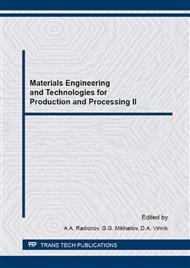[1]
I.N. Friedlander, Non-ferrous metals and alloys, Composite metallic materials: encyclopedia, volume II-3, Mashinostroenie, Moscow, (2001).
Google Scholar
[2]
M.B. Altman, G.N. Andreev, Application of the aluminum alloys: a Handbook, Metallurgy, Moscow, (1985).
Google Scholar
[3]
N.A. Belov, A.N. Alabin, A.R. Teleuova, Comparative analysis of alloying elements applied to the manufacture of heat-resistant aluminum-based wires, Metal Science and Heat Treatment. 9 (2011) 54-58.
DOI: 10.1007/s11041-012-9415-5
Google Scholar
[4]
Y.V. Matveev, V.P. Gavrilov, V.V. Baranov, Light conductor materials for aviation wires, Cables and Wires. 5 (2006) 22-23.
Google Scholar
[5]
Ch.L. Song, W.P. Sang, WO Patent 2013047986. (2013).
Google Scholar
[6]
A.D. Howells, Aluminium foil alloy, U.S. Patent 2012230862. (2012).
Google Scholar
[7]
Q. Zeng, CN Patent 102758109. (2012).
Google Scholar
[8]
X. Gao, CN Patent 102644002. (2012).
Google Scholar
[9]
N.I. Kolobnev, L.B. Ber, L.B. Hohlatova, D.K. Ryabov, Structure, properties and applications of alloys of Al-Mg-Si-(Cu) system, Metal Science and Heat Treatment. 9 (2011) 40-45.
DOI: 10.1007/s11041-012-9412-8
Google Scholar
[10]
N.A. Belov, V.D. Belov, A.N. Alabin, S.S. Mishurov, RU Patent 2478131. (2013).
Google Scholar
[11]
V.V. Zaharov, Joint alloying aluminum alloys with scandium and zirconium, Metal Science and Heat Treatment. 6 (2014) 3-8.
Google Scholar
[12]
N.A. Belov, A.N. Alabin, A.Y. Prohorov, N.B. Skvortsov, Influence of intermediate annealing on the resistivity and strength of wires made of low-alloyed aluminum alloys of the Al-Zr-Fe-Si system, Russian Journal of Non-Ferrous Metals. 4 (2012).
DOI: 10.1007/s11041-012-9475-6
Google Scholar
[13]
S.Y. Shevchenko, The effect of electromagnetic stirring during solidification on the structure of thixo-blanks from cast aluminum alloys, Russian Journal of Non-Ferrous Metals. 12 (2013) 24-29.
Google Scholar
[14]
F.B. Grechnikov, E.G. Demyanenko, I.P. Popov, Development of technology for obtaining aluminium alloys of high strength and high electrical conductivity, Russian Journal of Non-Ferrous Metals. 6 (2014) 17-21.
Google Scholar
[15]
V.A. Glouschenkov, A. Ju. Igolkin, D.G. Chernikov, V.I. Nikitin, B.V. Vyalov, Multi-phases and multi-components materials under dynamic loading, in: Proceeding of Materials of 10th European Mechanics of Materials Conference, Kazimierz Dolny, Poland. (2007).
Google Scholar
[16]
V.A. Glouschenkov, D.G. Chernikov, V.I. Nikitin, K.V. Nikitin, On the effects of pulsed magnetic fields on melts, Metallurgy of Machinery Building. 4 (2012) 47-50.
Google Scholar
[17]
A.M. Bibikov, F.V. Grechnikov, G.E. Goldbukht, E.G. Demyanenko, I.P. Popov, Principles of alloying deformable nanostructured conductor aluminum alloys, Metallurgy of Machinery Building. 5 (2013) 9-14.
Google Scholar
[18]
M.M. Rutman, G.V. Cherepok, M.M. Nonin, On the influence of the method of casting dopants on the properties of alloys cast by continuous method, in: Aluminum and special alloys, Kuybyshev, 1966, pp.10-16.
Google Scholar
[19]
V.I. Nikitin, A.D. Garin, O.A. Garin, Use of АК9М alloy in the aggregates production, Foundry, Technologies and Equipment. 10 (2000) 10-14.
Google Scholar
[20]
G.S. Lukyanov, A.D. Garin, V.I. Nikitin, RU Patent 2111286. (1998).
Google Scholar
[21]
M.M. Rutman, G.E. Goldbukht, A.P. Rubcov, Composition for introducing boron into aluminum alloys, RU Patent 580243. (1977).
Google Scholar
[22]
M.M. Rutman, G.E. Goldbukht, A.P. Rubcov, RU Patent 582315. (1977).
Google Scholar
[23]
I.P. Popov, E.G. Demyaninko, N.I. Kovrijnih, Casting by immersion in the manufacture of cylindrical billets and extruded profiles of aluminum alloy, Foundry, Technologies and Equipment. 13 (2006) 25-26.
Google Scholar


